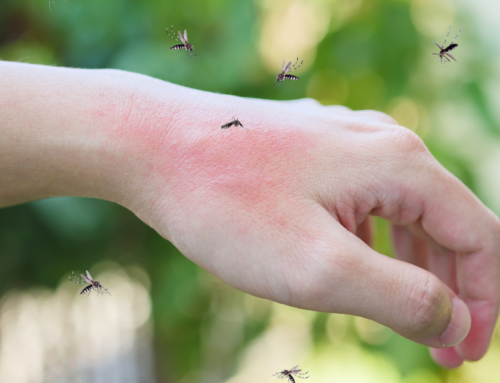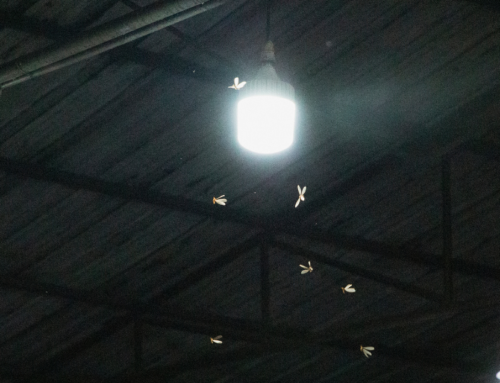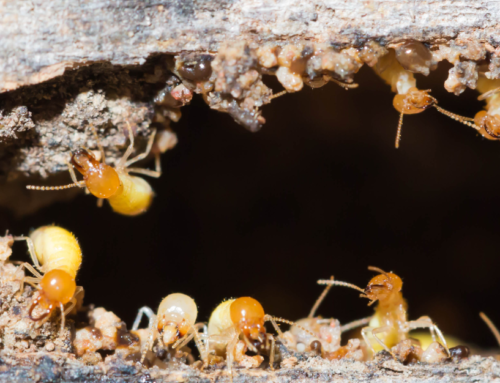We’ve all experienced it. You notice one tiny insect flying around your home. Then you see another one. And another. Before long, an entire horde of gnats is driving you batty. Keeping your home free of gnats is a handy life skill. Although they don’t bite, gnats can be very annoying and spread diseases from unhygienic places they land and breed.
When they’re outside, some gnats can be helpful as pollinators and by eating certain garden pests. What we call gnats can actually be several types of insects. Four of them are commonly found inside:
- Drain flies. Typically seen in or around drains, sewers, and septic tanks.
- Fruit flies. Love liquids and damp organic materials like fruits and vegetables.
- Phorid flies. Attracted to trash, drains, and decomposing fruits and vegetables.
- Fungus gnats. Hang around overwatered houseplants. Their larvae eat the plant roots, which can harm the plant. Fungus gnats are also known for spreading a pathogen that causes damping-off, which harms seeds and seedlings.
How to keep gnats away
Prevention is the easier than removal, so be sure to:
- Take out the trash often
- Throw out decaying fruit immediately
- Clean your drains regularly
- Let indoor plant soil dry completely between waterings
- Fix any plumbing leaks immediately
- Caulk foundation cracks and seal gaps around windows and doors
How to locate the source of the gnats
Gnats usually enter your home from outside, but occasionally they’ll catch a ride on decaying fruit. The best way to get rid of the infestation is to figure out where they’re breeding, but it’s not always easy. The location of the adult gnats may not be a good clue, because they’ll fly toward light and moisture. So adults may hover around windows and sinks regardless of where they originated.
Start by checking areas that consistently have wet organic matter:
- Decomposing fruit or vegetables. The shortest gnat life cycle takes nearly two weeks for the larvae to develop into adults. So if you have decaying veggies in your trash, compost container, or on your counter for longer than that, look there.
- Slow-moving or rarely-used sinks or drains. If a damp film or scum has built up above the water line, it’s a likely spot. To find out if gnats are breeding here, tape some plastic film over the drain to cover it. Within a day or two, adult gnats will start to accumulate underneath.
- Other wet areas. If there’s damp decaying organic matter, it’s a possible breeding site. Look under dripping pipes and refrigeration equipment, in trash cans and inside “empty” bottles and cans.
Stop bugging me!
Locating where the gnats are breeding and removing their source of food is the key, but this can be a process. If it’s under a dripping pipe, fix the leak. If it’s on decaying food, throw it out. If it’s overwatered plants, let the soil dry completely between waterings.
If the gnats are reproducing in a drain, it can take a little more effort to fix. You’ll need to find a way to clean the scum lining the inner surfaces.
Popular homemade solutions may help you catch a few adult gnats, but they won’t stop the problem at its source if you have an actual infestation:
- A vinegar trap. Mix a few tablespoons of vinegar (white or apple cider), a few drops of dish soap, and a tablespoon of sugar. Place the mixture where you see the most gnats. The sugar and vinegar attracts the gnats, while the dish soap traps them.
- A red wine trap. This is similar to the vinegar trap. Combine a few tablespoons of red wine with a few drops of dish soap. Place it out where the gnats will find it.
- A fruit trap. Place some overripe fruit in a jar and then cover the jar with plastic wrap. Poke some holes in the wrap. The gnats will enter the jar and then become trapped.
- A candle trap. Put a candle in a candlestick, and place that in a jar or other container. Partially fill the container with water. Light the candle, and then turn off as many lights as you can. The gnats will be attracted to the flame and either get scorched or fall into the water. Don’t leave this one unattended.
- Sticky paper or cards. These attract gnats with their yellow color and then trap them with an adhesive. Make sure not to place these outside where they can trap beneficial insects.
- A bug zapper. These electronic devices will attract gnats and then electrocute them. Make sure you purchase one that’s safe for indoor use. There are also insect traps on the market that work without electrocution.
Dealing with a gnat infestation
If you’re having a hard time managing a gnat infestation, we’re here to help! One of our pest control experts will take a look and make sure we get your home pest-free in no time. Schedule a visit today.







